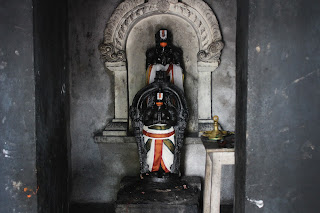Yoga Ramar Temple at Nedungunam
Nedungunam Village in Thiruvannamalai District of Tamilnadu is home to a unique temple of Lord Rama. It is the district’s biggest Vishnu temple built on 8 acres of land and besides other unique features, is the only temple for Rama that has the Lord in a sitting posture, sans weapons.
Pillar inscriptions attribute the temple structure to various kings and to be at least 700 years old. Though its construction was started by the Pallava rulers, it was completed during the reign of Krishnadevaraya who installed the idols in it. The five-tiered tall twin towers, the outer Rajagopuram (105 feet) and the inner, Kiligopuram (65 feet) honouring sage Shukha Brahmam, greet devotees to the temple. The seer himself stands close to the temple on the Dheerghachala Hill which resembles a parrot’s face. The hilltop has the feet of Lord Rama imprinted on it, along with the conch and disc.
According to legend, on the banks of River Kaliyar, the parrot-faced rishi Shukha, an ardent devotee of Lord Shiva, performed tapas meditating upon Shri Rama. Rama who was returning to Ayodhya after vanquishing Ravana and performing the coronation ceremony of Vibheeshana in Lanka, noticed the rishi’s austerities. He immediately alighted from the Pushpaka Vimanam and appeared before the seer. Further, in deference to the seer’s humble prayers, he halted here for a day, thereby displaying his sterling qualities of simplicity and non-discriminatory attitude towards all beings. Thus the name of the place, Nedungunam – Nedum meaning ‘noble’ and gunam meaning ‘quality’ in Tamizh, representing Sri Rama’s noble attribute.
Shuka who had the ability to transform himself to any form, changed himself to a parrot and flew to Kailash where he observed Lord Shiva initiating Goddess Parvati to some divine secrets. Shukha who wished to know the secrets, flew between the couple, angering Parvati. She cursed him to remain in the form of the parrot. Shiva showed benevolence when Shukha pleaded forgiveness, and said he would remain in human form, but with the parrot face.
In keeping with Vaishnavite temple design and architecture, twin dwarapalakas carved exquisitely, flank the entrance to the sanctum sanctorum. The inner most chamber housing the Moolavar or presiding deity is about 10 feet underground and one has to bend and enter carefully, signifying humility that is required before God.
The idol of the deity who goes by the name of Yoga Rama is made of stone, and unlike in other Rama temples is in a meditative posture, seated with his eyes closed. He is without any weapons, symbolising the reign of peace, following his battle with Ravana whom he slayed in Lanka. Rama is in in chinn mudra with his right hand on the chest and his left hand points towards his feet. Another unique feature of the temple is that Sita Devi is to the left of Sri Rama with a lotus in her hand, while the weapons-wielding Lakshmana is to Rama’s right. The trio of them are sitting on a peetam or pedestal inscribed with lionheads. Further, Rama assumes the role of Guru to Anjaneya, his greatest devotee, who is seen sitting and holding a palm leaf book, listening in rapt attention to his God and Master, Rama.
The temple has a pair of utsava murthis or processional idols made of panchaloham. Since the original idols of the utsava murthis were stolen, new ones were sculpted and installed. However, in time, the stolen statues were recovered and placed alongside the new ones. The processional idol, symbolising Rama’s victory over Ravana, is Vijaya Raghava Perumal with his consort Sengamalavalli Thayar. The God is portrayed holding the conch and disc in his upper hands with the lower right hand in abhaya mudra.
Goddess Sengamalavalli Thayar has a separate shrine for her, at the entrance to which are female dwarapalakas, sculpted just as beautifully as the Thayar herself.
The huge temple complex has individual shrines for Krishna, Sudarshana, Yoga Narasimha, Venkateshwara, Anjaneya and Vaikanasa, the preceptor of Vaikanasa Agama.
Depiction of Krishna Leela and Krishnadevaraya standing with folded palms in reverence and humility are sculpted in the pillars of its hall. Among the many mantapas adorning the temple courtyard, the twosome, one each on the left and right between the two gopurams, are replete with sculpted pillars.
The Kili Mantapam honours Maharishi Shukha and the Muthu Mantapam is named after Muthu, a Devadasi who it is claimed gave a performance in honour of Thirugnana Sambandar when he visited the shrine.
Devotees praying to Rama in this temple are believed to be bestowed with peace and enjoy prosperity of all forms. Those desirous of marriage and progeny pray to Sudharshana Azhwar. Abishekam with milk, curds, turmeric powder, sandal paste and honey, is performed for the presiding deity, Rama.
The pushkarini associated with the temple goes by the name Shukha Theertham and Surya Theertham. Vilwam is the sthala vriksham or sacred tree associated with the temple.
The Kaliyar River which begins its flow in this region terminates at Maduranthakam Lake near Chengalpattu, believed to be protected by Eri Katha Ramar (meaning, Rama who protected the lake). The two temples are thus connected by legend.
Quick Facts
Reaching:
Nedungunam is about 145 kms from Chennai, 51 km from Tiruvannamalai, 30 km from Arani and from 25 km Vandavasi. Buses ply from all these regions to Nedungunam.
Temple Timings: 6.00 a.m. to 11.00 a.m. and 4.00 p.m. to 8.00 p.m.
Festivals
On the second day of Pongal, known as Kanum Pongal or Kanu, the Utsava Murthy is taken in procession around the hill passing through various areas.
10 day Panguni (March-April) Brahmotsavam
Sri Ramanavami with the Rathotsavam on the 7th day and Indra Vimana festival on the 10th day.
Vaikasi Visakam (May-June)
Aadi Pavitrotsavam (July/August)
Tamizh and English New Year days, all Saturdays, Garuda Seva, Gokul Ashtami and Deepavali are celebrated with great devotion and fervour, marked by huge crowds.




































